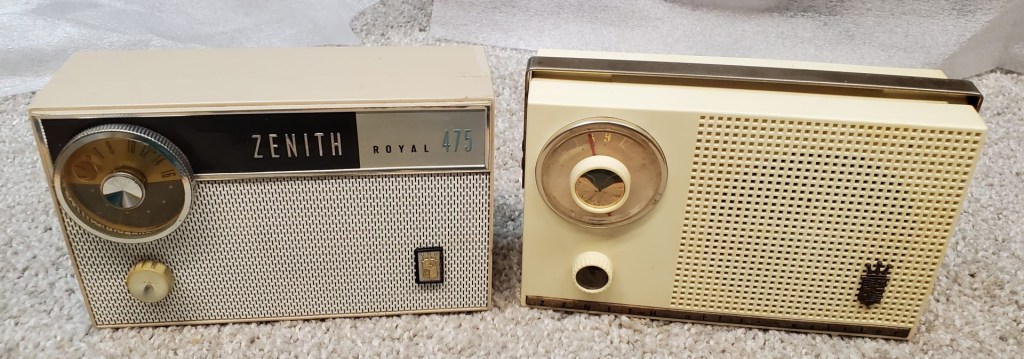Zenith Royal 450 & Royal 475 – 2 More Great Vintage Analog Portables

Above: Zenith Royal 450’s in Ebony, Beige and Orange
This is another entry in my look back at some of my favorite analog portable radios of the past. If you scroll down the Home Page you will see several of these radios which I’ve recently reviewed and more are planned. In this article we’ll take a look at two, perhaps lesser-known models from Zenith – the Royal 450 and Royal 475.
In its heyday Zenith Radio Corporation was a leader in electronic design, offering innovative products in many categories which competed with the best available. Zenith’s iconic top-of-the-line Trans-oceanics were highly regarded:

Above: Zenith Royal 475 in Ebony and Beige
Another singularly excellent and much-imitated series was the Royal 500:
which were widely considered the gold standard of quality.
The Royal 700 series “Lunchbox” radios are well-known as top performers in the larger mid-sized category:
But during the early transistor era spanning approximately 1955 – 1965, Zenith lead the way with a wide variety of models in every size and price range. For a wide look at Zenith transistor portables of this era I strongly recommend the book “Zenith Transistor Radios” by Norman Smith.
Both the Royal 450 and Royal 475 are 7 transistor horizontal designs and offer vernier tuning. Both measure approximately 6 ½” x 4 ¼” x 2”. Interestingly the 450 has a convenient pop-up handle while the 475 doesn’t. The Royal 450 uses separate oscillator and mixer transistors and has a two-gang air variable tuning condenser while the Royal 475 has a tuned RF stage and a three-gang air variable, and each runs on 6 AA batteries. They are both spec’d at 250 milliwatts “undistorted” power output and 400 milliwatts (Royal 450) or 450 milliwatts (Royal 475) max power output. And interestingly Zenith’s Service Manuals rate the 450 as having a sensitivity of “approximately 250 microvolts/meter for 50 milliwatts output” while the 475 is rated at 50 microvolts for the same 50 milliwatts output, which would seem to indicate that it is far more sensitive…more on that later. The Royal 450 retailed for $59.95 (equivalent to almost $600 in 2022!) and was available from 1958 – 1960 in Ebony, White and Orange. The Royal 475 was introduced as an upgrade for 1961 -1962. It retailed for $49.95 ($475 in 2022) and was available in Ebony or Beige.

Above: Left: Royal 475 – Right: Royal 450
A Great Gift from a Good Friend: Glen is a longtime friend of mine and a true radio lover. In the Navy he was Chief Engineer on a nuclear sub and he’s the kind of guy who can fix anything from cars to refrigerators to radios and is an expert on all of them. He is also a perfectionist and insists that repairs not only be effective but as true to the original as possible, and he has helped me with many repairs and restorations over the years. Out of the blue he presented me with five radios…three Royal 450’s and two Royal 475’s…a complete set in all the available colors. All were extensively rehabilitated as needed and he provided me with notes on each set showing what he had done to bring them back to life. These required more work than many Zeniths I’ve collected including the usual recapping but also ranging from replaced transistors, a speaker, a battery box and broken cabinet parts, followed by a complete alignment of each. And of course, they were all filled with fresh batteries…that’s 30 AA cells at 6 batteries each…an unbelievable act of kindness and generosity.


Checking Them Out: The first thing I did was to put them all side by side and begin to tune around with them. As usual there were slight unit to unit variations in their performance…something which I have often observed in vintage radios but all were (of course) working well. I was impressed by their overall performance which is very good for their vintage. To be sure they are not Superadios and do not fully compete with better radios of a decade later, but for 1958 and 1961 designs they represent the best you will find in their size and price range. Their smooth vernier tuning (which today’s digital radios ((with few exceptions)) can’t match) makes it a pleasure to scan the bands and they each have nice although different audio characteristics. The 450 has a crisper sound with more apparent high frequency response while the 475 has a mellower tonal shaping.
Reception: Earlier I had quoted Zenith’s specs which seemed to indicate that the 475 was much more sensitive than the 450 but I didn’t find that to be the case…rather I noted a more subtle difference in favor of the 475. I did note that the 475 was a hair more selective which is probably due to its tuned RF stage, but also possibly the 475’s mellower audio is partly the result of a slightly narrower IF bandwidth. But I am picking nits. Overall, they perform very similarly and all my usual stations were there with good reception and sound, and at night I had no trouble separating adjacent stations on a crowded dial…I very much like both of these radios.

Conclusion: I read that the Royal 450 enjoyed a limited production run and thus are hard to find with the orange version particularly sought after. I have no figures on how many of either of these models were produced but consider myself lucky to have been given the “complete set” by my good buddy Glen. They both represent the best quality available at their price in 1958 and 1961 respectively and I’ve had many hours of enjoyment from each of them. If you can find one in good condition, I highly recommend you snatch it up.
You must be logged in to post a comment.